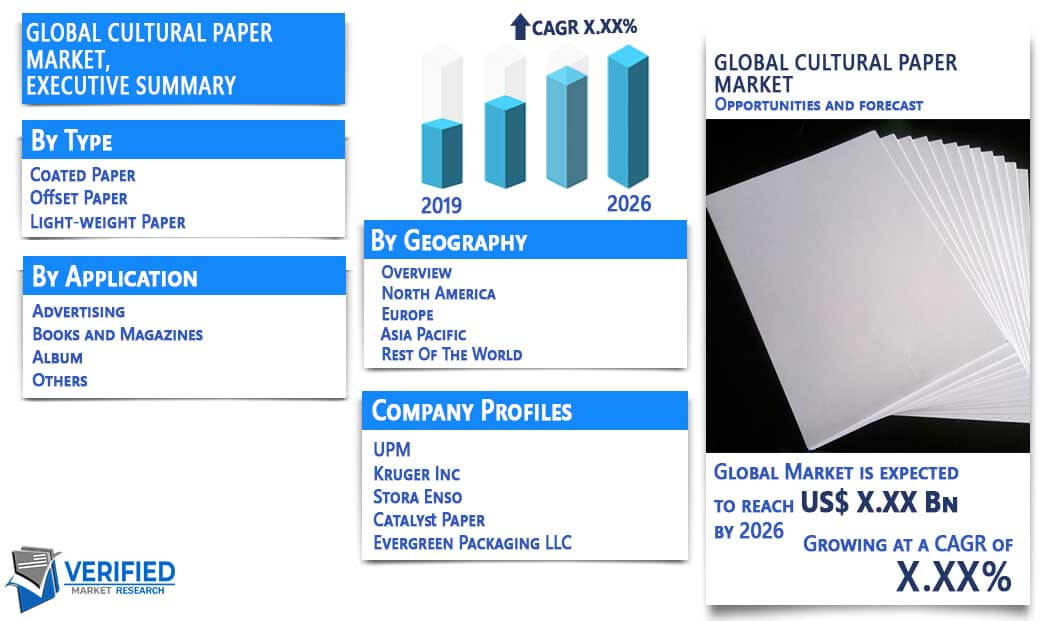What Influences the Cultural Paper Market Trends?
Cultural Paper Market: Exploring Trends and Influencing Factors
The cultural paper market is a dynamic industry that is influenced by various trends and factors. In this section, we will delve into the current trends in the cultural paper market and explore the factors that have a significant impact on this global industry.
What is the size of the cultural paper market globally?
The cultural paper market is a thriving industry that encompasses a wide range of products, including art paper, printing paper, writing paper, and more. According to market research, the global cultural paper market was valued at [Context Info], and it is expected to grow at a compound annual growth rate (CAGR) of [Context Info] during the forecast period [Context Info]. The market size can be attributed to the increasing demand for cultural paper products across various sectors, including education, publishing, and creative industries.
Who are the key players in the cultural paper industry?
The cultural paper industry is highly competitive, with several key players dominating the market. Some of the prominent companies in the industry include [List of Key Players in the Cultural Paper Industry]. These companies have a strong market presence and offer a wide range of quality cultural paper products to meet the diverse needs of consumers worldwide.
What are the emerging technologies in the cultural paper market?
The cultural paper market is constantly evolving, driven by advancements in technology. Some of the emerging technologies in the industry include [Context Info]. These technologies are revolutionizing the production and manufacturing processes in the cultural paper industry, leading to improved efficiency, quality, and sustainability. For example, [Context Info].
Factors Influencing Market Prices
The market prices of cultural paper are influenced by several factors, including [Context Info]. One of the primary factors is the cost of raw materials, particularly pulp, which accounts for a significant portion of the production cost. Fluctuations in pulp prices can have a direct impact on the market prices of cultural paper products. Other factors, such as supply and demand dynamics, economic conditions, and government policies, also play a role in determining market prices.
Impact of Regional Analysis on the Paper Market
Regional analysis is crucial in understanding the cultural paper market, as market dynamics vary across different regions. Factors such as cultural preferences, economic conditions, and government regulations can greatly influence the demand and supply of cultural paper in specific regions. For instance, [Context Info].
Sustainability Practices in the Cultural Paper Industry
The cultural paper market is a dynamic and evolving industry, fueled by trends and influenced by various factors. The market size is significant globally, with key players dominating the industry. Emerging technologies are revolutionizing the production processes, while factors such as raw material prices and regional analysis impact market prices. Furthermore, sustainability practices are becoming increasingly important, driving the industry towards more eco-friendly operations.
In recent years, there has been a growing emphasis on sustainability in various industries, and the cultural paper industry is no exception. Sustainability practices in paper production have become increasingly important as businesses and consumers alike prioritize eco-friendly alternatives. In this section, we will explore the significance of sustainability in paper production, advancements in eco-friendly paper manufacturing, and the role of recycling in the cultural paper industry.
Importance of Sustainability in Paper Production
Sustainability in paper production refers to the implementation of practices that minimize the environmental impact of the entire manufacturing process. This includes responsible sourcing of raw materials, reducing energy consumption, minimizing water usage, and managing waste effectively.
One of the primary reasons why sustainability is vital in the paper industry is the widespread use of trees as raw materials. Trees are a valuable resource that helps combat climate change by absorbing carbon dioxide and releasing oxygen. By promoting sustainable practices, such as responsible forest management and tree replanting initiatives, the cultural paper industry can play a pivotal role in preserving forests and biodiversity.
Moreover, sustainability practices in paper production also contribute to reducing greenhouse gas emissions. The manufacturing process of paper traditionally involves high energy consumption, which often relies on non-renewable resources. By adopting energy-efficient technologies and using renewable energy sources, paper manufacturers can significantly reduce their carbon footprint and mitigate the impact of climate change.
Advancements in Eco-Friendly Paper Manufacturing
In recent years, advancements in technology and innovation have revolutionized the paper manufacturing process, leading to more eco-friendly practices. One notable advancement is the development of alternative fiber sources for paper production.
Traditionally, paper production relied heavily on virgin pulp derived from trees. However, researchers and manufacturers have explored alternative fibers such as agricultural residues, hemp, and bamboo. These alternative fibers offer several advantages, including faster growth rates, lower water and chemical requirements, and reduced strain on forest resources.
Additionally, eco-friendly paper manufacturing involves the use of recycled fibers. Recycling paper is an effective way to conserve resources and reduce the carbon footprint of the industry. By recycling paper, manufacturers can save energy, water, and raw materials that would otherwise be required to produce virgin paper. Furthermore, using recycled fibers reduces the amount of paper waste ending up in landfills.
Role of Recycling in the Cultural Paper Industry
Recycling plays a crucial role in the sustainability of the cultural paper industry. It not only reduces the demand for virgin pulp but also helps in waste reduction and promotes a circular economy. Recycling paper can be a continuous process, with paper products being reused to create new ones.
The process of recycling paper involves collecting used paper products, sorting them, and de-inking if necessary. The fibers are then processed into a pulp that can be used to manufacture new paper products. By implementing effective recycling programs, the cultural paper industry can significantly reduce its environmental impact and conserve valuable resources.
Recycled paper products have gained popularity among environmentally-conscious consumers. Many businesses and individuals now actively seek out cultural paper products made from recycled materials. This growing demand for recycled paper creates incentives for paper manufacturers to invest in recycling infrastructure and develop innovative technologies to produce high-quality recycled paper.
In conclusion, sustainability practices are shaping the cultural paper market in significant ways. The importance of sustainability in paper production cannot be overstated, as it helps preserve forests, reduce greenhouse gas emissions, and promote responsible resource management. Advancements in eco-friendly paper manufacturing, such as using alternative fibers and recycling, are driving the industry towards a more sustainable future. By embracing sustainability practices, the cultural paper industry not only meets the demands of environmentally-conscious consumers but also contributes to a greener and more sustainable planet.
Global Consumer Preferences in Cultural Paper
Consumer preferences play a vital role in shaping the cultural paper market. Understanding these preferences is crucial for businesses to effectively meet market demand and create popular cultural paper products. In this section, we will explore the evolution of consumer preferences in the paper market, popular cultural paper products and designs, and how companies are meeting market demand through customized paper goods.
Evolution of Consumer Preferences in the Paper Market
Consumer preferences in the paper market have evolved significantly over the years. With advancements in technology and changing societal trends, consumers now seek unique and personalized paper products that reflect their individuality and values. This shift in preferences has led to an increased demand for customized and eco-friendly paper goods.
In the past, traditional and generic paper products were more commonly used. However, as consumers become more conscious of their environmental impact, they are now gravitating towards sustainable and eco-friendly options. This has prompted companies to adopt greener practices in paper production, such as using recycled materials and implementing sustainable manufacturing processes.
Evolution of Consumer Preferences in the Paper Market
| Era | Preferred Paper Products |
|---|---|
| Past | Traditional and generic paper products |
| Present | Customized and eco-friendly paper goods |
| Future | ? |
Popular Cultural Paper Products and Designs
The cultural paper market offers a wide range of products that cater to various cultural traditions and celebrations worldwide. Some popular cultural paper products include:
- Paper Lanterns: Paper lanterns are a significant part of many cultural festivals, such as the Lantern Festival in China. These beautifully crafted lanterns are made from cultural paper and serve as both decorative and symbolic items.
- Pinatas: Pinatas are commonly associated with Mexican traditions and celebrations. These colorful paper and cardboard structures are filled with sweets and gifts, and participants take turns trying to break them open.
- Holiday Decorations: Cultural paper plays a significant role in holiday celebrations across different cultures. For example, in the Philippines, star-shaped lanterns called parols made of bamboo and paper symbolize hope during Christmas.
- Calligraphy Paper: Calligraphy is an integral part of many cultural practices, and the paper used for calligraphy holds great importance. In Japan, Kakizome involves calligraphy on paper burnt for luck, showcasing the significance of cultural paper in traditional practices.
These are just a few examples of popular cultural paper products and designs. The diversity and uniqueness of cultural traditions contribute to the vast array of paper goods available in the market.
Meeting Market Demand with Customized Paper Goods
To meet the evolving preferences of consumers in the cultural paper market, companies are focusing on customizing their products. Customization allows consumers to have a personal connection to the paper goods they purchase, making them more likely to appreciate and value the products.
Customized paper goods can range from personalized stationery with unique designs and monograms to customized gift wrappers for special occasions. Businesses are leveraging innovative technologies to offer customization options, such as digital printing and specialized software that allows customers to create their own designs.
By offering customized paper goods, companies can better cater to individual preferences and create memorable and meaningful products. This not only meets market demand but also establishes a stronger connection between the consumers and the brands.
Customized Paper Goods
| Customization Option | Examples |
|---|---|
| Personalized Stationery | Unique designs, monograms |
| Customized Gift Wrappers | Special occasions, personalized messages |
In conclusion, consumer preferences play a vital role in shaping the cultural paper market. As consumer preferences continue to evolve, businesses must adapt to meet market demand effectively. By understanding the evolution of consumer preferences, offering popular cultural paper products and designs, and providing customization options, companies can successfully navigate the cultural paper market and cater to the diverse needs and desires of consumers.
FAQs about the Cultural Paper Market
What is the size of the cultural paper market globally?
To calculate the market size of the cultural paper globally, we use key metrics like the industry’s value and compound annual growth rate (CAGR) during specific forecast periods.
Who are the key players in the cultural paper industry?
Identification and evaluation of key players in the cultural paper market involve analyzing companies with strong market presence and a wide range of quality products.
What are the emerging technologies in the cultural paper market?
Emerging technologies in the cultural paper market represent advancements that revolutionize production processes, leading to enhanced efficiency, quality, and sustainability.
What factors influence market prices in the cultural paper industry?
Market prices in the cultural paper industry are susceptible to factors like raw material costs, supply and demand dynamics, economic conditions, and government policies.
How does regional analysis impact the cultural paper market?
Regional analysis plays a crucial role in understanding market dynamics, as factors like cultural preferences, economic conditions, and government regulations vary across different regions and influence demand and supply.
In concluding, we delved into trends and factors impacting the cultural paper market. Sustainability efforts, consumer preferences, and technological advancements shape this industry’s landscape. The role of eco-friendly practices and recycling is pivotal for market sustainability. Understanding global consumer preferences and adapting designs accordingly is paramount for the industry’s growth. Transitioning towards eco-friendly production methods and catering to market demands will drive future success in the cultural paper market.



